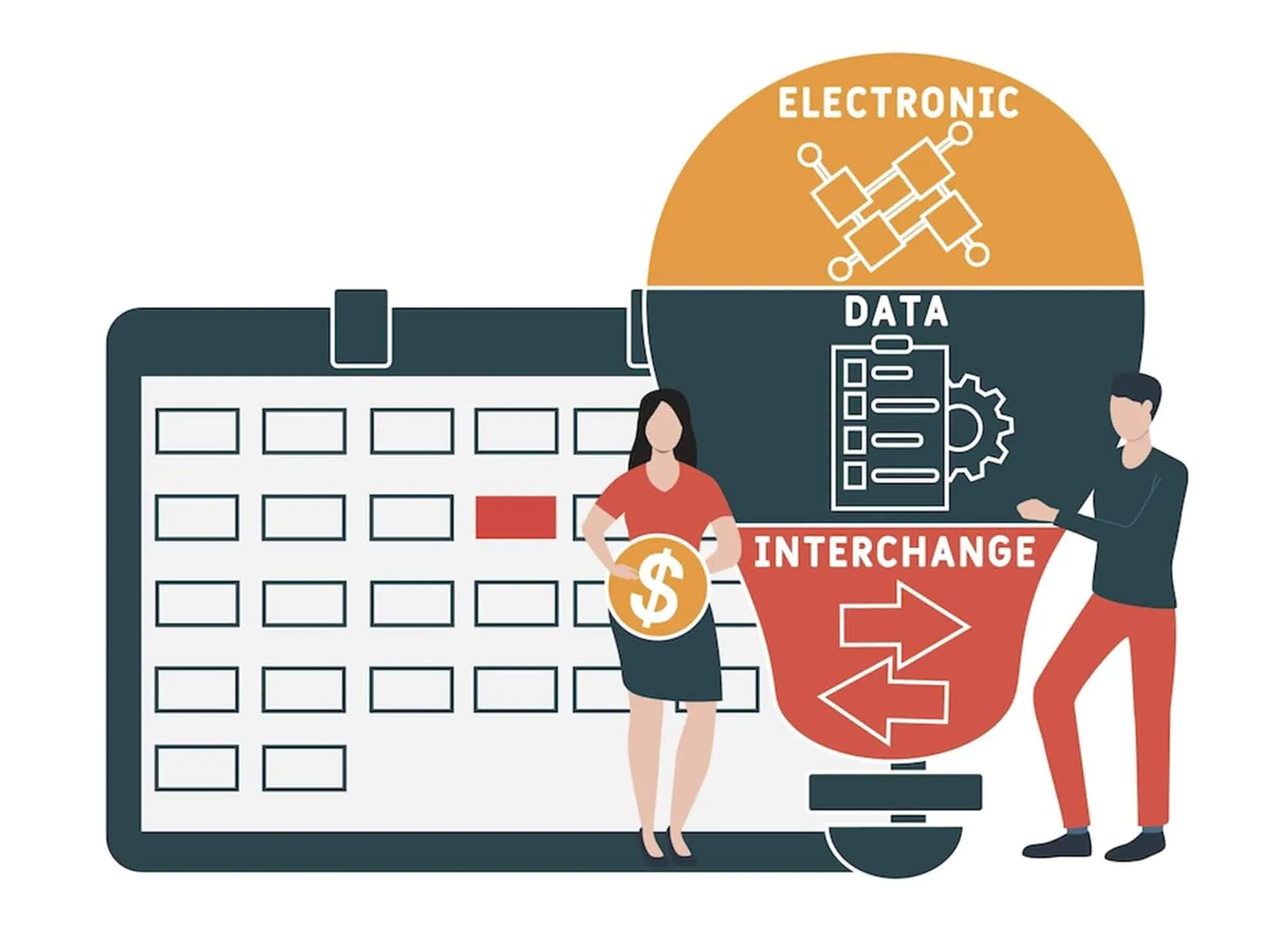EDI capability marks a crucial milestone for modern businesses—it’s what allows them to communicate electronically with precision and efficiency. So, what does being EDI capable mean? It simply means a business can exchange standardized documents with its partners swiftly over an EDI system. Exploring how this capability operates, and the ways it transforms business processes, is the focus of this guide.
Key Takeaways
- Being EDI capable means having the technological infrastructure to exchange electronic documents using standardized data formats, which streamlines operations and enhances partner communications.
- The journey to becoming EDI capable involves assessing business needs, selecting the right EDI solution, and thorough testing with partners, with a focus on integrating the solution into current systems to automate and improve business processes.
- EDI capability offers substantial advantages like improved efficiency, reduced error rates, and potential revenue increases, but also presents challenges in integration, compliance, and maintaining up-to-date systems that require strategic planning and adoption of new technologies.
Defining EDI Capable
EDI capability is more than just a buzzword—it’s a symbol of a company’s commitment to efficient operations and seamless communication. In simple terms, a company qualifies as EDI capable if it possesses the required resources to adopt and execute EDI software within its workings. To become EDI capable, a company must invest in the necessary infrastructure and training.
But what does this involve? Well, being EDI capable means:
- Having the technological infrastructure in place to connect with partners’ EDI systems
- Allowing for seamless electronic document exchange
- Laying the foundation for the transfer of business documents between trading partners using uniform data formats
Efficient electronic data interchange relies on the use of EDI messages as a vital part of the process, particularly when dealing with electronic documents, such as electronic business documents. To ensure smooth operations, it’s crucial to receive electronic business documents in a timely and accurate manner.
Key Components of EDI Capability
To fully grasp what it means to be EDI capable, we must first understand the key components that come into play. At its core, EDI capability relies on EDI software, which is crucial for handling EDI documents and converting them to and from a readable format for both inbound and outbound data.
However, the software is just the tip of the iceberg. A host of other elements contribute to building an efficient EDI system, including:
- Translators
- Standards
- Guidelines
- Mapping
- EDI processes
- Network services for secure data transmission
Not to mention the importance of real-time EDI transactions for improved efficiency, cost reduction, and heightened customer satisfaction.
The Path to Becoming EDI Capable
Having established the basics, let’s discuss the process of becoming EDI capable. This process comprises three fundamental steps: evaluating your business requirements, selecting the suitable EDI solution, and executing and verifying the selected system.
The initial steps involve:
- Evaluating your company’s specific needs
- Assessing the extent to which EDI can optimize your business processes
- Identifying your internal and external EDI transaction requirements driven by trading partners and industry standards.
This assessment is key as it helps identify your internal and external EDI transaction requirements driven by trading partners and industry standards. Ultimately, this will guide your adoption of the right EDI solution for your needs.
Assessing Your Business Needs
The initial move towards becoming EDI capable involves evaluating your business requirements. This requires undertaking a strategic review to determine how EDI can streamline your business processes, enhance customer service, and support wider business strategies.
To do this, you’ll need to perform an in-depth analysis to assess your readiness for EDI, its cost-effectiveness, and potential profitability. This analysis will help you prioritize where to implement EDI first and evaluate whether to manage EDI in-house or outsource it to a provider.
Choosing the Right EDI Solution
After a comprehensive look at your business needs, the next step involves selecting the appropriate EDI solution. This requires a strategic understanding of various deployment options such as in-house, hybrid, or fully outsourced EDI solutions.
Choosing the right EDI solution requires a thorough research process, including Q&A discussions and demonstrations, to determine the best fit aligned with organizational expertise and resources. It’s also crucial that the EDI solution you choose is business-focused, integrating technical and business considerations relevant to your company and its trading partners.
Implementing and Testing Your EDI System
Once equipped with an EDI solution, you’re now prepared to undertake the third step: executing and verifying your EDI system. This stage includes configuration, testing with trading partners, and deploying the solution throughout your business processes.
Thorough testing and quality assurance are necessary for a successful EDI implementation to minimize disruptions and ensure the system performs as expected. It is also crucial to start with a pilot project involving a select few business partners with extensive EDI experience, allowing for refining the system in a near-live environment.
Advantages of Being an EDI Capable Organization
Being an EDI capable organization is not merely about keeping pace with technology—it’s about harnessing a plethora of benefits that yield measurable business expansion. One of the most significant advantages is improved efficiency. EDI capability can significantly cut processing times by 50 to 60 percent, leading to a 40 percent reduction in data entry errors.
But the benefits don’t stop there. EDI systems support:
- Seamless business and logistics workflow automation
- Integration and simplification, which reduces supply chain delays and disruptions
- Potential to increase revenue upwards of $1 million or more due to improved supply chain agility, fostering stronger relationships, and creating new business opportunities.
Overcoming Challenges in Achieving EDI Capability
Although the route to becoming EDI capable is abundant with advantages, it also comes with its set of hurdles. Achieving EDI capability can be difficult due to complex business-to-business (B2B) networks that demand real-time connectivity with multiple stakeholders and integration with other business processes.
Fear not, for these challenges are not insurmountable. With strategic planning and the right resources, businesses can overcome technical challenges in EDI transactions, like errors and missing fields, that scale with transaction volume and raise security concerns.
Integration with Existing Systems
A major obstacle in reaching EDI capability involves its integration with pre-existing systems. This process involves connecting the EDI system with internal applications such as an ERP or WMS to automate data processing and facilitate business operations.
However, challenges often arise due to a variety of EDI dialects, outdated technologies, and data compatibility issues related to different data formats, structures, or naming conventions. Overcoming these challenges requires comprehensive planning, data mapping and transformation, and standardization processes.
Ensuring Compliance with Trading Partners
Maintaining compliance with trading partners presents another hurdle businesses encounter during EDI implementation. To achieve EDI compliance, businesses need to understand the specific requirements and EDI formats their trading partners expect for document exchange.
Maintaining positive relationships with trading partners is crucial, as non-compliance with EDI standards can result in chargebacks, payment delays, and detrimental impacts on vendor scorecards. Therefore, businesses need solutions capable of handling diverse data formats and standards to prevent compatibility issues.
Maintaining and Updating EDI Capabilities
Finally, preserving and updating EDI capabilities is crucial to remain competitive in the rapidly evolving business landscape. This involves handling increased transaction volumes and improving data quality through the implementation of data quality checks and validation rules.
Strategic changes in business operations necessitate considering the impact on existing EDI software and potentially upgrading or replacing it to support new business requirements, while also ensuring alignment with trading partner expectations and enterprise resource planning.
Case Study: Successful EDI Capability Implementation
Sometimes, the best way to understand a concept is through real-world examples. Let’s examine how industry giants like Walmart and Amazon effectively implemented EDI capability and capitalized on its benefits. Walmart’s adoption of EDI, has vastly increased efficiency through automated processes, leading to faster processing times and reduced human error.
Similarly, Amazon Vendor Central utilizes EDI for efficient information exchange related to purchase orders, shipments, and invoices. These examples clearly show how embracing EDI capability can lead to streamlined processes and enhanced efficiency, proving that the effort is well worth the reward.
Learn more about our Amazon EDI integration
Future Trends in EDI Capability
Looking ahead, EDI capability is poised to advance with the incorporation of technological breakthroughs such as artificial intelligence, machine learning, and blockchain. These technologies are being explored to improve and automate EDI processes for better data security, traceability, and simplification of payments and contracts.
Another exciting development is the consolidation of the Internet of Things (IoT) with EDI, leading to more automated and efficient data exchanges that positively impact inventory management and logistics tracking, thanks to the implementation of EDI cloud service.
Selecting an EDI Solution Provider
The path to becoming EDI capable is not a lone journey. You’ll need a reliable EDI solution provider to guide you along the way. When selecting an EDI provider, it’s paramount to match the provider’s strengths with your specific business needs, emphasizing their industry knowledge, scalability, and adaptability, in addition to customer service and their implementation history.
Remember, the level and quality of support and training given by an EDI provider directly influence the success of the solution’s implementation. Therefore, ensure your chosen provider offers extensive pre-implementation, implementation, and post-implementation assistance.
Harness EDI Capability with Comparatio’s Solutions
In the journey towards becoming EDI capable, the choice of technology partner is pivotal. Comparatio stands at the forefront, offering robust EDI solutions tailored to modern business needs. Our comprehensive suite of tools and services is designed to simplify the transition to EDI capability, ensuring your business can exchange documents with precision and efficiency.
Why Choose Comparatio for Your EDI Needs?
- Customized Solutions: Our EDI solutions are customized to meet the unique challenges and requirements of your business, ensuring seamless integration with your existing systems.
- Streamlined Operations: With Comparatio, streamline your operations with automated document exchange, reducing error rates and improving efficiency.
- Expert Support: Our team of experts is dedicated to guiding you through every step of the EDI implementation process, from initial assessment to full-scale Trading Partner testing, deployment and beyond.
Becoming EDI capable is more than an operational upgrade; it’s a strategic move towards enhanced efficiency, improved partner relationships, and a stronger competitive edge. With Comparatio, you’re not just adopting EDI technology; you’re embracing a future of streamlined, error-free business communication.
Summary
As we wrap up our journey through the world of EDI capability, we hope you now have a firm grasp of what it means to become EDI capable and the benefits it brings. From improved efficiency and cost savings to enhanced competitiveness and scalability, becoming EDI capable is a powerful tool in the hands of forward-thinking businesses.
Remember, challenges may arise along the way, but with strategic planning and the right resources, they are but stepping stones on your path to success. Embrace the future of business communication today and take your operations to new heights with EDI capability.
Ready to transform your business with EDI capability? Explore Comparatio’s EDI solutions and take the first step towards seamless electronic document exchange.
Frequently Asked Questions:
What does EDI stand for?
EDI stands for Electronic Data Interchange, which is the electronic exchange of business information using a standardized format to send information between companies.
Read more: What is EDI: Electronic Data Interchange Explained
How do you get EDI capable?
Becoming EDI capable involves a strategic approach that includes evaluating your business requirements, selecting an appropriate EDI solution that fits your needs, and integrating this solution into your existing systems. It requires investment in the necessary technology and infrastructure, training for your team, and possibly partnering with a reliable EDI provider to ensure seamless implementation and ongoing support. Thorough testing with your trading partners is also crucial to ensure the system works as intended and can handle your transaction volumes efficiently.
Is my business already EDI capable?
To figure out if your business is already set up for EDI, take a look at the tech and tools you’re using. If you have the software to swap business documents like orders and invoices electronically with your partners, and everything’s ticking along smoothly, you’re probably EDI capable. This means you’re using a common electronic language that both you and your partners understand. Not sure if you’re there yet? A chat with an EDI solutions expert can help clear things up, showing you exactly where you stand and what you might need to get fully EDI ready.




